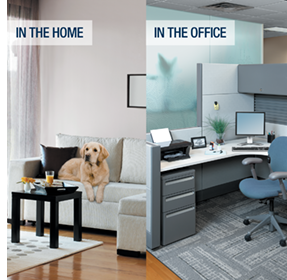Why Purify Your Indoor Air?
The air inside your home or office may be 2 to 5 times more polluted than the air outdoors1.
The Environmental Protection Agency (EPA) ranks indoor air pollution among the top 5 environmental risks to public health2.

Common Airborne Pollutants
Viruses - A cubic meter of air may contain 15,000 flu viruses3.WHY PURIFY?
Floating Dust - One ounce of dust contains nearly 42,000 living dust mites. Each mite is expelling 20 fecal pellets every day into the air you breathe.
Allergens - An estimated 1 in 5 Americans suffer from allergies. Allergy is the 5th leading chronic disease in the U.S. among all ages4.
Office Chemicals (toner, inks, etc) - Odors from felt markers, inks, glues, correction fluid, toner from copiers and other office chemicals can emit vapors.
Cigarette Smoke and General Household Odors - Both women and men exposed to heavy indoor smoke are 2-3 times more likely to develop chronic obstructive pulmonary disease5.
Pet Dander - 100% of U.S. households have detectable levels of dog and cat dander4. Short-haired or hairless animals contribute dander and allergens to indoor air pollution just as effectively as longhaired animals do. There is no such thing as a non-allergenic dog or cat6.
Where These Airborne Pollutants can be Found in your Home and/or Office:
Air Vents - Central air handling systems can become breeding grounds for mold, mildew, and other sources of germs such as viruses and bacteria, which can then distribute these contaminants throughout a home or office7.
Furniture and Upholstery - Dust particles on upholstered furniture can contain textile fibers, decomposing insect parts, pet dander and the flakes of human skin-all of which is released into the air anytime anyone sits down8.
Carpet - Carpet can hold 8 times its weight in dirt, pesticides and other toxins (such as automotive fluids from parking lots and lawn pesticides) brought in on shoes and even bare feet. When dry, these toxins become undetectable airborne particles.
Office Dividers - Cube divider walls can become magnets for allergens such as dust and pollen. Office dividers are the closest to your breathing space while you work and hold some of the most inhaled indoor pollutants.
Where These Airborne Pollutants can be Found in your Home and/or Office:
Air Vents - Central air handling systems can become breeding grounds for mold, mildew, and other sources of germs such as viruses and bacteria, which can then distribute these contaminants throughout a home or office7.
Furniture and Upholstery - Dust particles on upholstered furniture can contain textile fibers, decomposing insect parts, pet dander and the flakes of human skin-all of which is released into the air anytime anyone sits down8.
Carpet - Carpet can hold 8 times its weight in dirt, pesticides and other toxins (such as automotive fluids from parking lots and lawn pesticides) brought in on shoes and even bare feet. When dry, these toxins become undetectable airborne particles.
Office Dividers - Cube divider walls can become magnets for allergens such as dust and pollen. Office dividers are the closest to your breathing space while you work and hold some of the most inhaled indoor pollutants.
How to Remove Airborne Pollutants from Your Air:
Using air purifiers to keep your household environment cleaner is your first step to better indoor air. Air purifiers with a True HEPA Filter will safely remove 99.97% of airborne pollutants as small as 0.3 microns from your air.
Below are other steps that you can take to help keep your indoor air cleaner.
Floating Dust - Typical feather dusters only put dust into the air for you to breathe. To reduce the amount of floating dust, use microfiber dusters or a dust cloth to dust your home. Also, regularly change the air filters in your furnace to help reduce excess dust from circulating in your ventilation system.
Cigarette Smoke - If you smoke, smoke outside. Cigarette smoke in an enclosed area lasts longer in the air becoming inhaled secondhand smoke to others in the home. A new concern with smoking in the home is third-hand smoke, a term used to describe smoke that lingers on surfaces such as furniture, rugs, drapes or other household items long after the cigarette has been put out. These residual smoke particles contain over 200 toxins that can be released into the air of the home.
Upholstery and Carpet - Regularly clean upholstered furniture and your carpet to reduce the amount of air pollutants that may be settled there. Dust particles on upholstered furniture can contain textile fibers, decomposing insect parts, pet dander and the flakes of human skin - all of which are released into the air anytime anyone sits down. Carpet can hold 8 times its weight in dirt, pesticides and other toxins (such as automotive fluids from parking lots and lawn pesticides) brought in on shoes and even bare feet. When dry, these toxins become undetectable airborne particles.
Pet Dander - Beyond using your air purifier, you can take further steps to reduce pet dander in your home by simply keeping pets off upholstered furniture and restricting them to rooms with wood floors. Upholstery and carpet retain pet dander for long periods and release the dry particles back into the air. Wash pet beds, mats or soft toys which can also become pet dander magnets.
Sources
- An Introduction to Indoor Air Quality (IAQ). United States Environmental Protection Agency. Last modified July 9, 2012. www.epa.gov/iaq/voc.html
- Action to Improve IAQ. United States Environmental Protection Agency. Last modified April 5, 2012. www.epa.gove/iaq/schools/actions_to_improve_iaq.html
- Journal of the Royal Society Interface
- Asthma and Allergy Foundation of America
- World Health Organization
- American Lung Association
- An Introduction to Indoor Air Quality (IAQ). United States Environmental Agency. Last modified June 21, 2012. www.epa.gov/iaq/biologic.html
- Dust Mites and Dust. American Lung Association. Accessed November 14, 2012. www.lung.org/healthy-air/home/resources/dust-mites-and-dust.html
